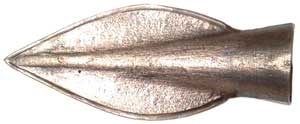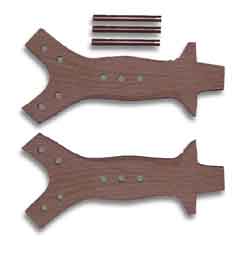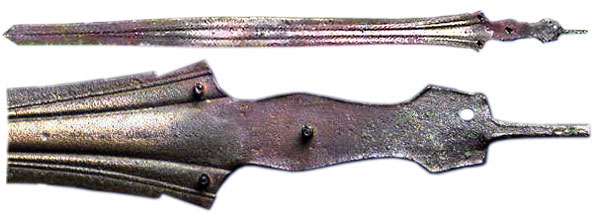The sword blades are supplied as cleaned and polished castings, with the edges hardened but not sharpened.
Swords Available
 |
| Budget Khopesh Based on a khopesh from Tutankhamun’s tomb. Length 60cm, 630g, |
 |
| The Hallstatt C Mindelheim Sword Late Bronze Age, high status cavalry sword. . Length 82.5cm, 1000g, |
 |
| The Limehouse Sword Late Bronze Age, Length 75cm, |
 |
| Mycenaean Type G (Horn Sword), This sword was found at the Mycenae Acropolis. Length 45cm, |
 |
| khopesh Middle Bronze Age, Canaanite “sickle- sword ” Length 60cm, |
 |
| Small Spearhead Late Bronze Age, Classic small spearhead Length 12.7cm, |
 |
| Arrow head Late Bronze Age, Rare find in Britian, probably based on flint barbed and tanged arrow heads Length 4.7cm, |
 |
| BASAL-LOOPED SPEARHEAD Classic Irish spearhead Length 41cm |
 |
| EWART PARK (BUDGET VERSION) Classic leaf shaped blade from the late Bronze Age. Basic casting for for DIY finishing. Length 60cm, 700g, |
 |
| URNFIELD (Classic wide leafed blade sword from Europe) Based on an original is in The British Museum Length 60cm, 850g |
 |
| EWART PARK Classic leaf shaped blade from the late Bronze Age this is available in two sizes. Length 68cm, 700g, |
 |
| NAUE II Classic Aegean straight edged blade used throughout the ancient world, from the Aegean to Europe. Length 63cm, 600g, |
 |
| Aegean type II variant B Classic Mycenae short sword (dagger). Length 39.5 cm |
 |
| Carp’s Tongue Sword One of the few complete swords of this type found in the river Thames.The original can be seen in the Museum of London. Length 74 cm |
 |
| Hilt Kits £The hilt kits consist of two handle shells and a pommel in oak, copper rivets are supplied with them but some degree of skill is needed to rivet them on, if you don’t think you posses the necessary skills you can always buy a finished sword. |
Apart from the design, the three qualities that you would look for in a bronze sword are, weight, balance and alloy, the level of skill Bronze age sword makers achieved with clay casting technology is stunning, and the fact that no one can match them today, is even more humbling.
Weight
Bronze swords rarely exceeded 800 grams, if it is over 1 kilo it is way to heavy “(it’s a lemon”). Due to the difficulty of casting swords in sand, most foundries will cast on the heavy side, and although the end results would look good in a glass case, they bare no comparison to a genuine Bronze Age weapon.
Balance
It is interesting that if you were to look at the balance point on bronze age swords, its much nearer the handle than you would expect, the blades taper evenly toward the point, and are not end heavy.
Alloy
The alloys used in the bronze age for swords, on average, vary from 8% to 12% tin and in later swords the lead content varies 1% to 5% depending on the tin content. My personal feelings are that the hardness of sword alloys could not exceed the hardness of the tools used in the process of edge hardening.
All bronze age sword edges were hardened and sharpened at the same time, the edges were forged down to a thin, hard wafer. The work is so neat, its not easy to understand how they achieved it.
Over the past couple of years I have had some interesting interactions with archaeologists researching bronze swords. Subsequently I have come to the conclusion that we only see bronze swords in drawings in one dimension, and have little understanding of their weight, balance and how they were used.
The first thing we would all say, when a bronze age sword was paced in are hands is, “it’s so small”, and they were small! It is only by the end of the bronze age that swords were getting any thing like the size we imagine, so 67cm would be a very big sword, and would probably weigh around 700 grams.
“What’s so good about, my swords?”
I hear you ask. I cast my swords vertically in very hot stone moulds. This means I can cast swords at the right weight, it also means I get a better structure to the bronze. As the casting method is nearer the bronze age method, I use a 12% tin/copper alloy which is at the top end for tin content for a bronze age sword. This casts well and gives a nice stiff blade. I mix all my own alloys and never use soft silicon bronzes.
Hardened Edges
One of the most beautiful things about the bronze age swords are the recasso edges, which are forged in. All my swords come with hardened edges, done in the (forged in) bronze age method. The forging is quite time consuming and I believe I am the only person able to do this at the moment. I cast all my blade as near to a sensible weight for bronze age sword as possible, and tuning a mould might take me many days and up to nine castings until I am happy.
In recent television programme for the BBC, one of my bronze swords was repeatedly stuck against a reproduction of an early iron sword, in a test to show the advantages of iron over bronze. Even though both myself and Hector Cole (the iron sword maker) had advised the programme makers the that the bronze sword would do better than expected, they were very surprised. The bronze sword was more than a match for the iron, both blades received heavy damage. The ability of bronze to rapidly work harden under impact, and the lack of carbon in early iron swords must have created a bit of a technological stand off around 700bc. At this time the art of the bronze caster was at its height and iron working was in its infancy.
In my work as a bronze sword maker i try to catch the essence of sword making in the bronze age and get as close as possible to the originals.
To pay for a sword you will need to contact me for bank payment details, and you will also need your bank to Transfer the money in Pounds Sterling, be aware your bank will charge you for conversion and money transfer.
Custom Swords
If they made it in bronze, big or small , I can make it, but my work is limited to swords of ancient times, if its something you want to make.
The Hallstatt C Mindelheim Sword
 |

First finished Mindelheim on it’s way to the USA. Pommel and shells in imitation ivory.
This is the second test casting following five days work on the stone mold. Since this casting I have widened the handle to the full extent as shown in the blue print of the Kemmathen sword. I still have to produce molds of the bronze handle shells and bronze pommel. Casting length 83cm and weight is 1Kg.